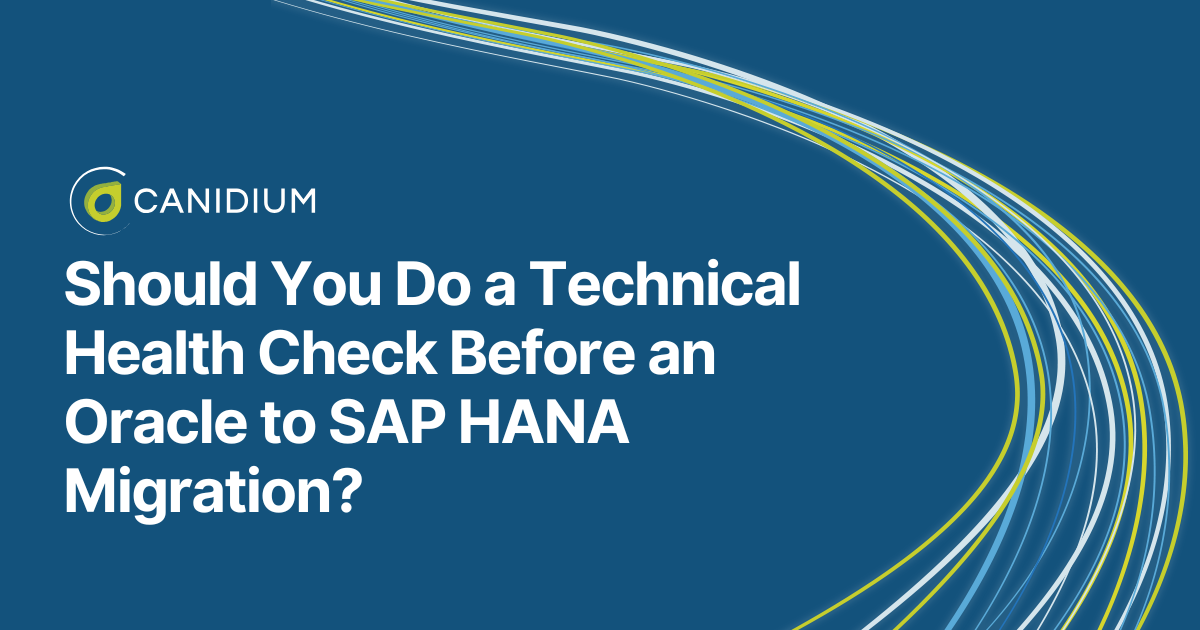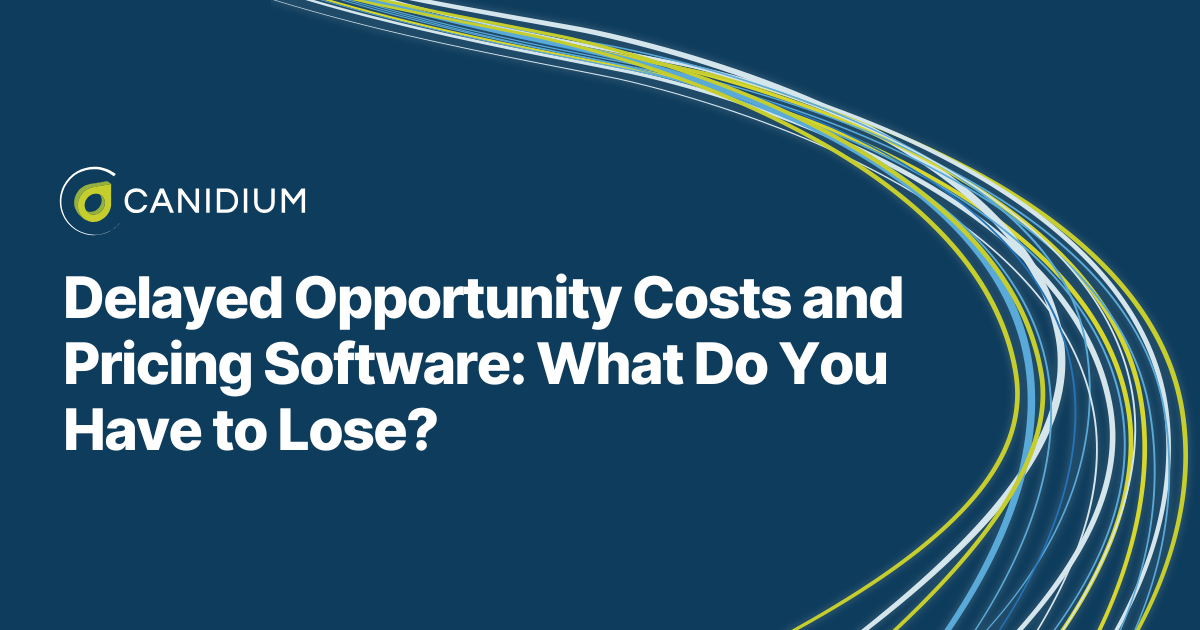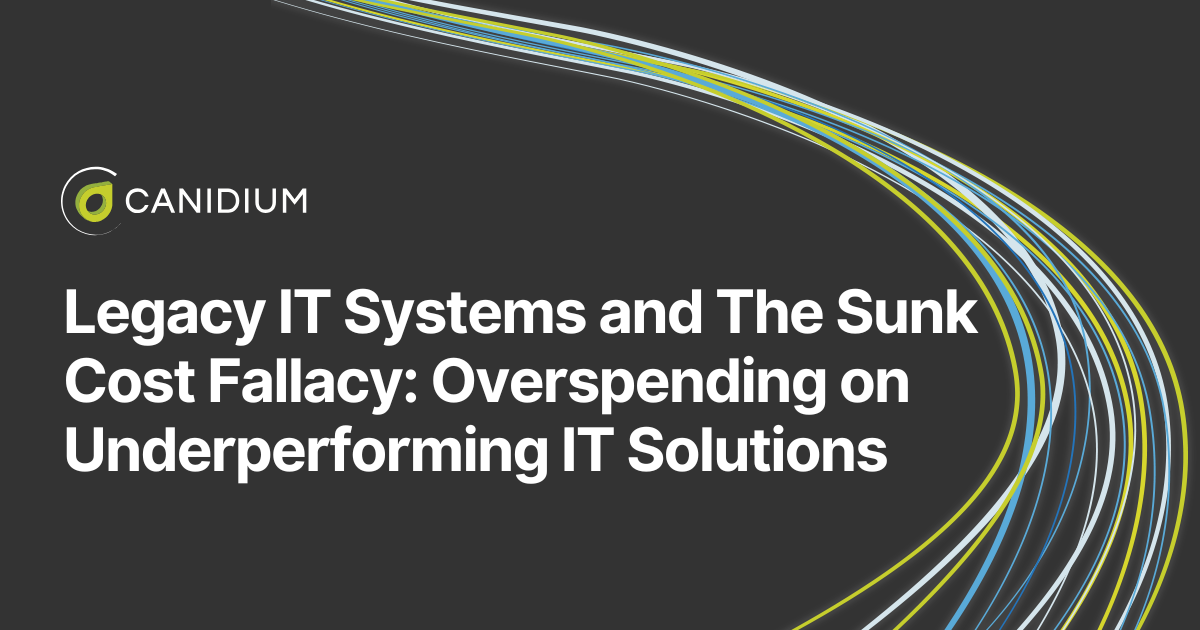Migrating your data from Oracle to SAP HANA can significantly improve system efficiency. However, the project is also highly technical, requiring an in-depth understanding of your existing data and system components to maximize your project returns. This begs the question: Should you do a technical health check before you initiate your system migration?
At Canidium, our experts help organizations optimize the technical health check process for their unique business needs and project goals. We explain the costs and benefits of different approaches to the THC process, helping clients determine the most effective and cost-efficient way to optimize their solution.
Leveraging our experts' collective experience, this article will help you determine if performing a technical health check before migrating from Oracle to SAP HANA is right for you.
- The Benefits of Going Through a Technical Health Check Before Migrating From Oracle to SAP HANA
- Estimating The ROI of Performing a Technical Health Check Before an Oracle to SAP HANA Migration
The Benefits of Going Through a Technical Health Check Before Migrating From Oracle to SAP HANA
In a nutshell, comprehensive technical health checks (THCs) are conducted to thoroughly explore and diagnose potential issues or inefficiencies in your current system. This deep dive helps uncover hidden problems, such as bugs in dashboard functionalities or process flow inefficiencies that might be overlooked because users have become accustomed to their existing system's quirks.
The rationale for performing a THC before migrating to SAP HANA is underscored by the desire to not only fix what is broken in Oracle but to fully leverage the advancements in HANA. Instead of merely transferring existing problems into a new, more capable environment, conducting a THC ahead of time allows for preemptive corrections or, at the very least, detailed documentation of potential concerns. This proactive approach minimizes the risk of post-migration complications. It reduces the need for what could otherwise become a costly and extended engagement to rectify issues after the system goes live.
Here's an in-depth exploration of the full scope of benefits that early THCs can offer:

Maintain the Long-term Value of Your Incentive Compensation Management Solution
Think of your enterprise system as a high-performance vehicle. Just as a car requires regular oil changes to keep its engine running smoothly, an enterprise system needs periodic reviews to ensure it operates efficiently. By regularly changing the oil, you prevent the buildup of harmful substances that can cause engine components to wear out faster and eventually fail. Similarly, a THC for your Oracle system identifies and addresses small issues before they become significant problems. Consequently, the partner performing the technical health check can craft a type of user manual in the form of documentation for your system as they perform the migration to HANA, meaning you will not only have a bug-free introduction to SAP HANA but will also benefit from detailed materials on its inner workings.
Put simply, investing in a technical health check before migrating to SAP HANA allows companies to avoid costly repairs and downtime, ensuring a smoother, more cost-effective transition.
Regular updates, product releases, and optimizations align the system with current business practices and technological advancements. Performing a THC before you migrate from Oracle is a preemptive approach to troubleshooting. Through early THCs, your partner can take care of system issues ahead of time. As a result, you avoid the costs of fixing existing issues within your data or performing updates post-migration while also preventing workflow disruptions down the road.
Solving System Inefficiencies Before SAP HANA Goes Live
When preparing for a migration from Oracle to SAP HANA, it's crucial to address existing inefficiencies to ensure a smooth transition and optimal system performance post-migration. The process of fixing these inefficiencies continues throughout the migration to SAP HANA, it is not just a preliminary step. This ongoing effort is akin to regular software updates on an iPhone—easy for the end-user but essential for maintaining the efficiency and reliability of the system.
The first step of this process is to set priorities for system fixes. Organizations can prevent significant downtime and potential revenue loss by focusing first on the most critical issues—those that have the greatest impact on system functionality and business processes. This prioritization also helps streamline the migration process, ensuring that urgent and severe problems are resolved before they can cause further complications, thereby enhancing the overall stability and performance of the new system post-migration. Additionally, prioritizing fixes based on a structured assessment helps maintain project momentum and stakeholder confidence by achieving key improvements early in the migration process.
When technical health checks are performed concurrently, or prior to the migration process, it becomes more than just a data transfer—it's an enhancement of the entire system's architecture. This proactive approach ensures that the new system is not just a different version of the old solution with the same inherent problems. Instead, it becomes a significantly improved platform that leverages SAP HANA's advanced capabilities to deliver superior performance and reliability.
Reducing the Cost of Managed Services
Investing in a technical health check prior to your migration project can save managed service costs down the line. If you don't fix data errors or perform necessary updates prior to your implementation, you will need to do them after the fact—thereby preventing you from immediately realizing the benefits of SAP HANA.
An early THC helps identify whether there are any critical issues or priorities to account for before migration or if the system is largely efficient as is. Understanding the extent of necessary fixes then allows you to accurately estimate how many hours of managed services you will need. This assessment prevents you from overcommitting resources to problems that are either non-existent or trivial after your migration project, which can be a common pitfall in migrations. Also, you can significantly reduce later costs by carefully assessing service needs and choosing the appropriate engagement model.
Low-Risk Engagement Options
If you partner with a managed service provider that provides flexible payment structures, you can use the detailed information uncovered during your technical health check to set the exact number of managed service hours you want to commit to.
The key is to work with a provider that offers diverse payment structures. For instance, Canidium offers managed services that emphasize low-risk engagements, providing clients with flexibility and control over their spending. There are two primary payment structures designed to suit different organizational needs and risk profiles:
Prepaid Bucket of Hours
Clients can choose to prepay for a set number of service hours. This model is particularly cost-effective because it usually comes with discounted hourly rates. It also provides access to a dedicated, named resource team that is already familiar with the client's system, enhancing the efficiency and effectiveness of the service provided. This option is ideal for organizations that clearly understand their needs and prefer to have consistent support after their migration process.
Pay-As-You-Go
Alternatively, the pay-as-you-go plan offers on-demand services without long-term commitments. This flexibility is advantageous for organizations with varying project demands or those uncertain about the extent of services they might require. Contracts are flexible and tailored to specific projects, and clients only pay for the services they use. While this option may not offer the same reduced hourly rate as the prepaid model, it reduces financial risk by avoiding upfront expenditures.
Estimating The ROI of Performing a Technical Health Check Before an Oracle to SAP HANA Migration
The financial commitment for performing a technical health check before migrating from Oracle to SAP HANA is relatively modest compared to the overall cost and scale of the migration itself. Typically, a THC involves an intensive four-week period of discovery where the current system is analyzed to identify any existing issues that could affect the performance of the new system. The cost for this discovery phase can range between $30,000 and $50,000, depending on the scale and complexity of your project.
While this may seem like a substantial outlay, it is a prudent investment when considered against the backdrop of the total cost of a full migration to SAP HANA. Investing in a THC early on also allows an organization to make informed decisions by clearly understanding the state of its current system. It helps pinpoint critical issues that need addressing before or during the migration, thus ensuring that the new system does not inherit old problems.
Moreover, the cost of a THC is low when you consider the potential savings it offers. By identifying and addressing system issues early, a THC can prevent costly post-migration fixes and downtime, which not only saves money but also accelerates the return on investment from the new system. It also ensures that the organization can fully leverage the advanced capabilities of SAP HANA without being bogged down by legacy issues, making the system more efficient and aligned with business needs right from the start.
To estimate the ROI of a THC, consider the direct cost savings from reduced need for post-migration services and the indirect benefits of improved system performance and stability. Calculate the cost of potential downtime, additional post-migration fixes, and extended project timelines without a THC and compare these to the initial investment in the THC. Typically, the savings and benefits far exceed the initial cost, especially considering the high costs associated with extended downtimes and emergency fixes post-migration.
Preparing For an Oracle to SAP HANA Migration With a Technical Health Check
Conducting a technical health check before migrating from Oracle to SAP HANA ensures a smoother and more cost-effective transition. By thoroughly examining the current system to diagnose and address inefficiencies or bugs, a THC prevents the migration of existing problems into the new, more advanced environment of SAP HANA. This proactive approach not only minimizes the risk of post-migration complications but also reduces the need for costly and extended engagements to rectify issues after the system goes live. Additionally, such upfront assessments help craft detailed documentation that serves as a valuable guide for optimizing the system during and after migration.
Moreover, investing in a THC offers substantial economic benefits. It enables organizations to better manage their resources by accurately estimating the necessary scope of managed services, thus avoiding overinvestment in post-migration corrections. This strategic planning, combined with the choice between flexible payment structures like prepaid hours or pay-as-you-go options, allows you to maintain control over spending while also benefiting from a migration that enhances system functionality. In most cases, the modest upfront investment in a THC is justified by the significant savings and improved operational efficiency it delivers, making it a wise decision for any business preparing for the transition from Oracle to SAP HANA.
If you want to learn more about migrating from Oracle to SAP HANA, read this step-by-step guide.








